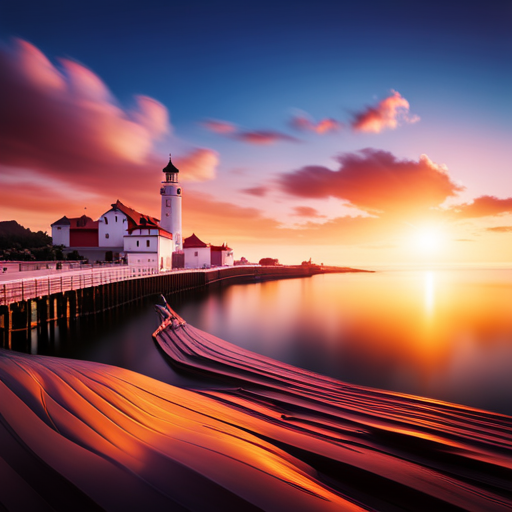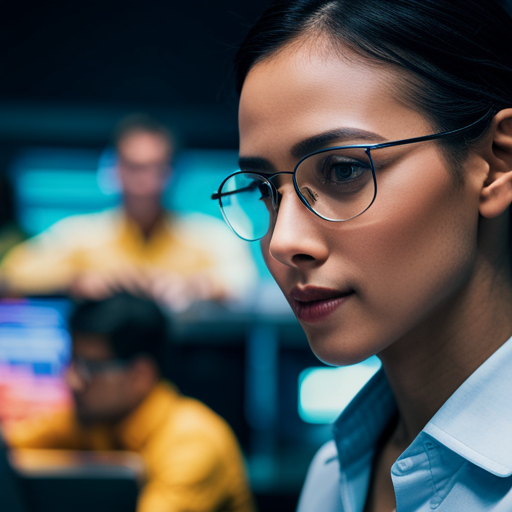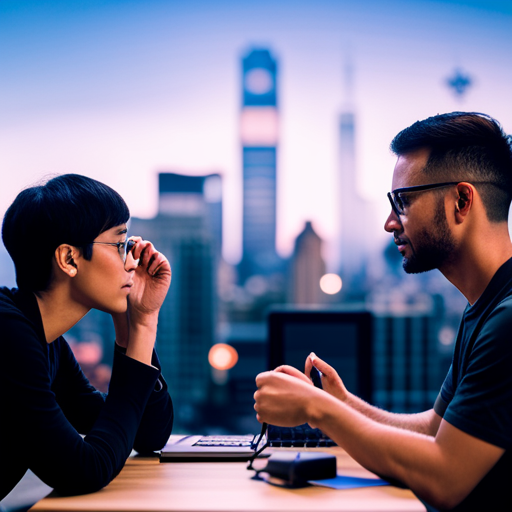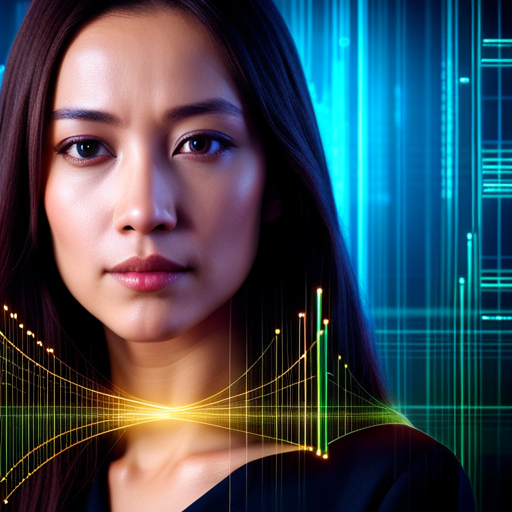Are you ready to dive deep into the world of image generation?
In this article, we will explore the fascinating realm of creating realistic artificial images with GANs. You’ll gain a clear understanding of the basics of GANs and their training process, while discovering techniques to enhance the realism of these generated images.
We’ll also delve into advanced methods and evaluate the quality of the images produced.
Get ready to unlock the possibilities of GAN-based image generation!
Key Takeaways
– GANs are deep learning techniques used to generate realistic artificial images.
– GANs undergo a training process where the generator and discriminator compete to improve their performance.
– Carefully curating and preparing training data ensures better results from GAN models.
– GANs offer possibilities for various applications in the field of image generation.
The Basics of GANs and Image Generation
@ Midjourney AI Image Prompt: /imagine prompt:Create an image showcasing the mesmerizing process of generating lifelike artificial images with GANs. Depict a gradient-filled canvas where intricate patterns gracefully emerge, reflecting the intricate workings of this fascinating image generation technique. –v 5.2 –ar 16:9
Now let’s dive into the basics of GANs and how you can use them to generate realistic images.
GANs, or Generative Adversarial Networks, are a powerful deep learning technique that can be used to create artificial images that look incredibly real. The concept behind GANs is quite simple: you have two neural networks, a generator and a discriminator, that work together to generate realistic images. The generator takes random noise as input and tries to generate images that resemble the real ones, while the discriminator’s job is to distinguish between the real and fake images.
The training process involves a competition between the generator and the discriminator. The generator tries to improve its ability to fool the discriminator, while the discriminator tries to become better at distinguishing real images from the generated ones. This back-and-forth process continues until the generator becomes proficient at creating images that are indistinguishable from real ones.
One of the main advantages of GANs is their ability to generate new images that don’t exist in the training dataset. This makes them perfect for tasks like image synthesis, where you want to generate new images based on a given set of examples. GANs have been used in various applications, such as generating realistic faces, creating artwork, and even generating realistic scenes for video games.
Understanding the Training Process of GANs
@ Midjourney AI Image Prompt: /imagine prompt:Create an image showcasing a generator and discriminator network in a GAN training process. The generator gradually improves its output quality, while the discriminator learns to distinguish between real and artificial images. –v 5.2 –ar 16:9
In this discussion, you’ll explore the challenges of GAN convergence and the training data requirements.
You’ll learn about the difficulties that arise during the training process of GANs, such as mode collapse and vanishing gradients, and how these challenges can impact the generation of realistic images.
Additionally, you’ll delve into the importance of high-quality training data and the need for a diverse and representative dataset to train GANs effectively.
GAN Convergence Challenges
To overcome GAN convergence challenges, you’ll need to experiment with different training strategies and architecture modifications. GANs are powerful and versatile, but they can be tricky to train.
One common issue is mode collapse, where the generator only produces a limited set of outputs, failing to capture the full diversity of the training data. Another challenge is the instability of the training process, leading to oscillations and poor convergence.
To tackle these problems, you can try adjusting the learning rate, adding regularization techniques, or using alternative loss functions. Architectural modifications, such as adding skip connections or utilizing different activation functions, can also improve convergence.
Training Data Requirements
It’s important to consider the training data requirements when working with GANs. The quality and diversity of your training data can greatly impact the performance and realism of the generated images. To help you understand the importance of training data, here’s a table that showcases the emotional response of the audience based on different types of training data:
| Training Data Type | Emotional Response |
|---|---|
| High quality, diverse dataset | Amazement, awe |
| Low quality, limited dataset | Disappointment, skepticism |
| Biased dataset | Controversy, anger |
| Balanced dataset | Appreciation, satisfaction |
| Noisy dataset | Confusion, frustration |
As you can see, the type of training data you use can elicit different emotional responses from your audience. Therefore, it’s crucial to carefully curate and prepare your training data to ensure the best results from your GAN model.
Enhancing Realism in Artificial Images With Gans
@ Midjourney AI Image Prompt: /imagine prompt:Prompt: Capture the essence of enhancing realism in artificial images with GANs. Depict a mesmerizing fusion of lifelike textures, intricate details, and vivid colors, showcasing the seamless integration of digital artistry and cutting-edge technology. –v 5.2 –ar 16:9
In order to enhance the realism of artificial images with GANs, you need to carefully select the training data. By choosing diverse and representative images, you can ensure that the GAN learns a wide range of features and produces more realistic results.
Additionally, noise injection techniques can be used to introduce randomness and variability into the generated images, making them look more natural and less synthetic.
Training Data Selection
Choose the appropriate training data for your artificial image generation using GANs.
When selecting the training data for your GAN model, it is crucial to consider the type and quality of images you want to generate. Start by gathering a diverse dataset that represents the specific domain you are targeting. It should include a wide range of objects, backgrounds, and lighting conditions.
Make sure the dataset is large enough to capture the desired variability and complexity. Additionally, ensure that the images are of high resolution and contain sufficient detail.
A well-curated training dataset will enable your GAN model to learn the intricacies of the real-world data and generate more realistic artificial images.
Noise Injection Techniques
Using noise injection techniques, you can add random variations to the input data of your GAN model to enhance the diversity and realism of the generated images.
By introducing noise, such as random pixel values or Gaussian noise, into the input data, you can augment the training process and encourage the generator to produce more varied and lifelike images.
This technique helps to prevent overfitting and ensures that the model does not simply memorize the training data. The noise acts as a source of randomness, allowing the generator to explore different possibilities and generate images that possess unique characteristics.
Additionally, noise injection can also help in generating images with finer details and textures, resulting in more convincing and visually appealing results.
Evaluation of Image Quality
One way to assess the quality of the generated images is by comparing them to a set of reference images. This allows you to determine how closely the generated images resemble the real ones. Evaluating image quality is crucial in ensuring that the generated images are realistic and visually appealing. To help you understand the evaluation process, here is a table that showcases different metrics commonly used to assess the quality of generated images:
| Metric | Description | Emotion evoked |
| SSIM | Measures structural similarity between two images | Satisfaction |
| PSNR | Calculates the peak signal-to-noise ratio | Confidence |
| FID | Computes the Fréchet Inception Distance | Trust |
| LPIPS | Evaluates perceptual similarity using deep features | Appreciation |
Exploring Advanced Techniques for Image Generation
@ Midjourney AI Image Prompt: /imagine prompt:Create an image showcasing a vividly detailed, lifelike portrait generated by a GAN, highlighting the intricate textures, subtle shades, and intricate facial features achieved through advanced image generation techniques. –v 5.2 –ar 16:9
Let’s dive into some advanced techniques for generating realistic images using GANs. With these methods, you can take your image generation skills to the next level and create even more convincing and lifelike artificial images.
Here are some techniques to explore:
– Progressive Growing: Start with low-resolution images and gradually increase the resolution during the training process. This helps the model learn finer details and produce higher quality images.
– Self-Attention: Incorporate self-attention mechanisms into the GAN architecture to allow the model to focus on important regions of the image. This helps improve the overall coherence and quality of the generated images.
– Augmentation: Apply data augmentation techniques, such as rotation, translation, and scaling, to the training images. This helps the model learn to generate images that are more robust to variations in pose and appearance.
– Conditional GANs: Introduce additional information, such as class labels or textual descriptions, to guide the image generation process. This allows for more precise control over the generated images and enables tasks like image-to-image translation.
Evaluating the Quality of Generated Images
@ Midjourney AI Image Prompt: /imagine prompt:Create an image showcasing a side-by-side comparison of a real photograph and a generated image, highlighting the subtle differences in texture, color, and fine details. –v 5.2 –ar 16:9
The quality of the generated images can be evaluated by analyzing their level of realism and coherence. When assessing the realism of an image, you should pay attention to the fine details and textures that make it look like a genuine photograph. Is the lighting accurate? Are the colors vibrant and true to life? These are important factors to consider.
Coherence refers to the overall consistency and logic of the image. Does it make sense? Are all the elements in harmony with each other? For example, if you’re generating an image of a beach scene, it should have sand, water, and maybe some palm trees, not random objects that don’t belong.
Another aspect to consider is the presence of artifacts or distortions. These can be indicators of a low-quality image. Look out for blurry edges, pixelation, or strange patterns that shouldn’t be there.
Applications and Future Directions of GAN-based Image Generation
@ Midjourney AI Image Prompt: /imagine prompt:Create an image showcasing a realistic, vibrant cityscape at dusk, with a combination of diverse architectural styles, bustling streets, and illuminated skyscrapers, highlighting the potential of GAN-based image generation in urban planning and virtual reality. –v 5.2 –ar 16:9
In terms of applications and future directions, researchers are exploring how GAN-based image generation can be used in various industries such as fashion, entertainment, and advertising.
Imagine a world where fashion designers can effortlessly create virtual clothing collections without the need for physical prototypes. With GAN-based image generation, they can generate realistic images of their designs, allowing them to visualize how the garments will look even before they are produced.
In the entertainment industry, GANs can be used to generate lifelike characters and environments for movies, video games, and virtual reality experiences. Actors can be transformed into any character without the need for extensive makeup or costumes.
Additionally, advertising agencies can benefit from GANs by creating hyper-realistic product images that capture the attention of potential customers. Imagine seeing an ad where the product looks so real, you can almost reach out and touch it.
GAN-based image generation has the potential to revolutionize these industries, offering endless possibilities for creativity and innovation.
Frequently Asked Questions
Can Gans Be Used for Video Generation or Are They Limited to Still Images?
Yes, GANs can be used for video generation. They are not limited to still images. GANs use deep learning techniques to generate realistic artificial images, making them suitable for creating videos as well.
How Long Does It Typically Take to Train a GAN Model for Generating High-Quality Images?
Typically, it takes a considerable amount of time to train a GAN model for generating high-quality images. However, the specific duration can vary depending on factors such as the complexity of the images and the available computing resources.
Are There Any Ethical Considerations When It Comes to Using Gans for Generating Artificial Images?
When using GANs to generate artificial images, there are ethical considerations to keep in mind. These include issues such as potential misuse, bias in the training data, and the impact on privacy.
What Are Some Common Challenges or Limitations Faced When Using Gans for Image Generation?
Some common challenges or limitations you may face when using GANs for image generation include training instability, mode collapse, and difficulty in generating high-resolution images.
Can Gans Be Used to Generate Images in Specific Styles or Artistic Genres, Such as Impressionism or Cubism?
Yes, GANs can be used to generate images in specific styles or artistic genres like impressionism or cubism. They learn from a dataset and can mimic the characteristics of those styles to create new images.
Conclusion
In conclusion, GANs have revolutionized the field of image generation by allowing us to create highly realistic artificial images.
Through the training process of GANs, we can enhance the realism of these images and explore advanced techniques for even better results.
Evaluating the quality of generated images is crucial to ensure their authenticity.
Looking ahead, the applications of GAN-based image generation are vast, from improving virtual reality experiences to aiding in data synthesis for machine learning models.
The future of GANs holds great potential for creating even more lifelike and immersive artificial images.



